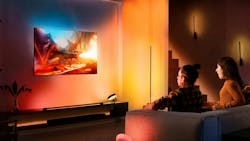It’s been about 8 months since Signify’s CEO pledged action to perk up sales of the Hue smart lighting line. While no big push has emerged, the company has taken a couple of smaller steps. Most recently, it strengthened ties with Samsung to sync room lighting with home televisions.
Seoul-based Samsung is now embedding Signify’s Philips Hue Sync TV app in its own SmartThings mobile app. The two companies have also added support for music, and have started offering a subscription option for the service.
Samsung TV viewers in the U.S. and some European countries were already able to connect their Hue lights and television sets, coordinating action on films and shows with different lighting displays and scenarios. Previously, users set up the connectivity from the Signify side of things. Now, they can come in from the Samsung side as well.
“The app allows users to adjust the settings with their smartphone without having to interrupt the TV content,” Signify said in a press release. “With the SmartThings app, users can choose between different modes and start or stop syncing. Moreover, it allows users to create multi-device automations to create the perfect movie setting with the push of a button.”
The settings can now respond to the music in a film, whereas previously the Signify app allowed lighting to respond to video content only.
Signify has priced the new subscription option at $2.99 in the U.S., at €2.99 in Europe, and at currency-equivalent levels in other countries. It has also added Brazil, Hong Kong, Poland, the Czech Republic, and Slovakia to the areas where it is providing the feature.
The app works with Samsung’s Q60 or higher series of QLED TVs manufactured from 2022 onward.
Signify pioneered smart lighting with the introduction of Hue back in 2012, when Signify was called Philips Lighting. Hue bulbs and the Hue connected system offer variable colors, spectra, and intensity. Signify has over the years had some success with Hue. But following the business bonanza of the stay-at-home COVID lockdown era, sales plunged.
Last summer, Signify boss Eric Rondolat said that the company would take measures to stimulate sales, noting that “We need to reinforce the position of our offer.” He indicated at the time that the company would stress the advantages of Hue over other brands, and that it would add features that enhance Hue’s effectiveness as a home security system.
Within the next few months, it did indeed add those features.
But some analysts believe that the main issue underlying Hue’s decline is the exorbitant price that Signify charges compared to makers of other smart bulbs and systems. Rondolat has downplayed pricing as a factor, and the company has yet to make any drastic price reductions.
Instead, it is taking iterative and niche measures, such as adding to its Samsung TV offering.
The residential/consumer sector has seen greater uptake of smart lighting systems than the commercial building sector. According to a 2023 report by market research firm Parks Associates, consumer demand for connected lighting has been driven by concerns around energy usage and costs, as well as improved interoperability between smart home assistants and other devices. The commercial lighting and controls industry continues to advocate for the additional energy savings potential and advanced features that integrated systems can offer in the wider building market. Although the journey has been slow, the industry has also set its sights on open protocols and interoperability through standards harmonization and product ecosystems.
MARK HALPER is a contributing editor for LEDs Magazine, and an energy, technology, and business journalist ([email protected]).
Follow our LinkedIn page for our latest news updates, contributed articles, and commentary, and our Facebook page for events announcements and more. You can also find us on the X platform.

Mark Halper | Contributing Editor, LEDs Magazine, and Business/Energy/Technology Journalist
Mark Halper is a freelance business, technology, and science journalist who covers everything from media moguls to subatomic particles. Halper has written from locations around the world for TIME Magazine, Fortune, Forbes, the New York Times, the Financial Times, the Guardian, CBS, Wired, and many others. A US citizen living in Britain, he cut his journalism teeth cutting and pasting copy for an English-language daily newspaper in Mexico City. Halper has a BA in history from Cornell University.





